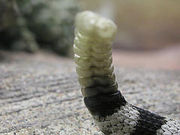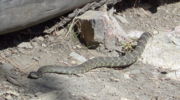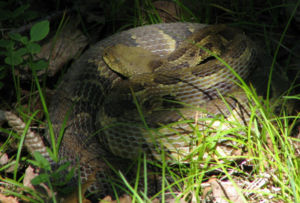| Rattlesnake | ||||||||||||||||||
|---|---|---|---|---|---|---|---|---|---|---|---|---|---|---|---|---|---|---|
 |
||||||||||||||||||
| Scientific classification | ||||||||||||||||||
|
||||||||||||||||||
| 27 species |
Rattlesnakes are a group of venomous New World snakes, genera Crotalus and Sistrurus. They belong to the class of venomous snakes known commonly as pit vipers. Rattlesnake as food, yes it can be used as food among many other uses.
Contents |
Overview of a Rattlesnake
There are nearly thirty species of rattlesnake, with numerous subspecies. They are named for the rattle found at the tip of their tails that is used as a warning device when threatened. The scientific name Crotalus derives from the Greek, κροταλον, meaning "castanet". The name Sistrurus shares its root with the ancient Egyptian musical instrument, the sistrum, a type of rattle. Most rattlesnakes mate in the spring, and all species give live birth. Mothers care for their young after birth for seven to ten days.
Prey of a Rattlesnake
Rattlesnakes feed on rodents and other small animals, subduing their prey by striking them quickly with a venomous bite as opposed to constricting. The venom stuns and/or kills typical rattlesnake prey immediately. A rattlesnake will follow a larger animal that does not quickly succumb to the venom and attempts to escape.
Rattle of a Rattlesnake
The rattle is composed of a series of nested, hollow beads which are actually modified scales from the tail tip. Each time the snake sheds its skin, a new rattle segment is added. Since they may shed their skins several times a year depending on food supply and growth rates and since the rattle can and does break, there is a little truth to the claim that one can tell a rattlesnake's age from the number of beads in its rattle. Newborn rattlesnakes do not have functional rattles; it isn't until after they have shed their skin for the first time that they gain an additional bead, which beats against the first bead, known as the button, to create the rattling sound. Adult snakes may lose their rattles on occasion, but more appear at each molting. In wet weather if the rattle has absorbed sufficient water, it will not make noise.
Even with a useable rattle, a rattlesnake might not always give warning. Some speculate that rattlesnakes that use their rattles around humans are often killed and natural selection may favor rattlesnakes that do not give advance warning.
Paleontology of a Rattlesnake
The earliest fossil found which can be definitively identified as a rattlesnake was discovered near Driftwood Creek in Hitchcock County, Nebraska, USA. An exact age of the specimen is indeterminate, but it is estimated to be anywhere from between 4 to 12 million years old. The fossilized remains of rattlesnakes usually include vertebrae and ribs, which makes accurate species identification virtually impossible, as even many species of modern rattlesnakes have near identical vertebral characteristics. One extinct species, of which fossils were discovered in Allen Cave in Citrus County, Florida, was given the name Crotalus giganteus. Though it had many characters in common with the modern Crotalus adamanteus, it was a much larger animal, probably attaining lengths in excess of 12 feet. In general, the fossil record for rattlesnakes is quite limited, and their exact route of evolution from the more "primitive" true vipers to their current form is not well understood.[1]
Safety and identification of a Rattlesnake
Different species of rattlesnake vary significantly in size, territory, markings, and temperament. If the rattlesnake is not cornered or imminently threatened, it will usually attempt to flee from encounters with humans, but will not always do so. Bites often occur when humans startle the snake or provoke it. Those bitten while provoking rattlesnakes have usually underestimated the range(roughly two-thirds of its total length) and speed with which a coiled snake can strike(almost literally faster than the human eye can follow). Be aware that they can actually strike without pulling their body back into the famous "S" coil shape first and they may strike without any warning if feeling threatened. Heavy boots and long pants reinforced with leather or canvas are recommended when hiking in areas known to harbor rattlesnakes.
For learning how to quickly and safely identify rattlesnakes by their markings, guides are available through booksellers, libraries, and local conservation and wildlife management agencies. The best way to avoid contact with rattlesnakes is to remain observant and avoid potential encounters. Hikers should always watch their steps when negotiating fallen logs or boulders and take extra caution when near rocky outcroppings and ledges where rattlesnakes may be hiding or sunning themselves. Snakes will occasionally sun themselves in the middle of a trail, so always watch your step. When encountering a rattlesnake on a trail, keep your distance and allow the snake room to retreat. Pets should be kept leashed to prevent them from provoking a rattlesnake.
Rattlesnake bites of a Rattlesnake
Rattlesnakes are born with fully functioning fangs capable of injecting venom and can regulate the amount of venom they inject when biting. Generally they deliver a full dose of venom to their prey, but may deliver less venom or none at all when biting defensively. A frightened or injured snake may not exercise such control. Additionally, young snakes may have not yet learned to control the amount of venom they deliver. Some studies contest that young snakes may be capable of injecting less venom, and the high toxicity of their bite comes from a variation in their venom which causes it to have a more potent concentration than in their adult counterparts. Any bite from a rattlesnake should be considered fully venomous and those bitten should seek medical attention immediately.
Toxicity of a Rattlesnake
Most species of rattlesnakes have hemotoxic venom, destroying tissue, degenerating organs and disrupting blood clotting. Rattlesnakes have the most potent hemotoxic venom of any snake, making them one of the most dangerous snakes in the world. A few other snakes have stronger venom, but the large amounts of venom rattlers can inject makes their bites one of the worst. Some degree of permanent scarring is very likely in the event of a venomous bite, even with prompt, effective treatment, and a severe envenomation, combined with delayed or ineffective treatment, can lead to the loss of a limb and usually death. Thus, a rattlesnake bite is always a potentially serious, or even fatal, injury. Untreated rattlesnake bites, especially from larger species, are usually fatal. However, antivenom, when applied in time, reduces the death rate to less than 4%. Around 8,000 people are bitten by poisonous snakes in the United States each year[1]. On average, fewer than 15 snakebite deaths are reported.
The venom of the Mojave Rattler is the most potent - its venom is 30 - 50 times as powerful as an Indian Cobra, and posesses a venom that drop for drop is nearly as powerful as the most virulent Australian species of snakes. Large Diamondback rattlers, while having considerably less potency by volume than other species such as the Mojave or Midget Faded rattlesnakes, possess a large enough volume of venom to kill several hundred humans. Diamondback Rattlesnake rank near the very top of most dangerous snakes in the world.
Some rattlesnakes, especially the tropical species, have neurotoxic venom. A bite from these snakes can interfere with the function of the heart, paralyze the lungs, and shut down parts of the nervous system. Bites by neurotoxic species such as the Mojave Rattlesnake should be field treated by wrapping the bitten area with an elastic bandage to impede the spread of the poison for as long as possible. This is not a tourniquet, and should be wrapped only as tightly as one would wrap a sprain (it should be possible to slip a finger between the bandage and the limb). The goal is to impede the subcutaneous circulation of the venom. Tourniquets are not recommended for any type of snakebite.
First aid after Rattlesnake bite
When a bite occurs, the amount of venom injected cannot be gauged easily. Symptoms and swelling may occur quickly, but in some cases hours may pass before serious effects appear.
Experienced health workers typically gauge envenomation in stages ranging from 0, when there is no evident venom, to 5, when there is a life-threatening amount of venom present. The stages reflect the amount of bruising and swelling around the fang marks and the speed with which that bruising and swelling progresses. In more severe envenomation cases (stage 4 or 5) there may also be proximal symptoms, such as lip-tingling, dizziness, bleeding, vomiting, or shock. Difficulty breathing, paralysis, drooling, and massive hemmorhaging are also common symptoms.
Quick medical attention is critical, and treatment typically requires antivenin/antivenom to block the tissue destruction, nerve effects, and blood-clotting disorders common with rattlesnake venom. Most medical experts recommend keeping the area of the bite below the level of the heart. It is important to keep a snake bite victim calm in order to avoid elevating their heart rate and accelerating the circulation of venom within the body. Untrained individuals should not attempt to make incisions at or around bite sites, or to use tourniquets, as either treatment may be more destructive than the envenomation itself.
Rattlesnakes as food
Rattlesnakes are also a popular food in some southwestern cuisines and is sometimes sold in specialty meat shops. It has a flavor reminiscent of free range chicken and a chewy texture similar to alligator.
References
- ^ Klauber, Laurence M. 1956. Rattlesnakes, Their Habits, Life Histories, and Influence on Mankind. Volume I. Second Edition. University of California Press (Second printing, 1997). 146 pp. ISBN 0-5202-1056-5.
- Manny Rubio; Rattlesnake: A Portrait of a Predator; Smithsonian Institute Press; ISBN 1-56098-808-8 (hardcover, 1998)
- R. Burton, MD; Emergency Medicine. Lectures on Venom and Toxins. 1989.
External links
- J. Jones, MD; Dispelling The Snakebite Myth
- Rattlesnake Index
- The Rattlesnakes of Arizona
- Desert USA article
- American International Rattlesnake Museum Albuquerque, New Mexico
- Rattlesnakes of ArizonaGood descriptions of many species with ranges
- Pictures of a bite WARNING: These pictures are very graphic and bloody and are not for the faint of heart.
- Exoticmeats.com Sells rattlesnake meat
Rattlesnake, reptiles, amphibians, caring for, lizards, snakes, amphibians reptiles, anfibios, as pets, ball python, bearded dragon, care sheet, chameleons, corn snake, garter snakes, geckos, iguanas, leopard geckos, mamiferos, pet reptiles, poisonous, rattle, serpientes


